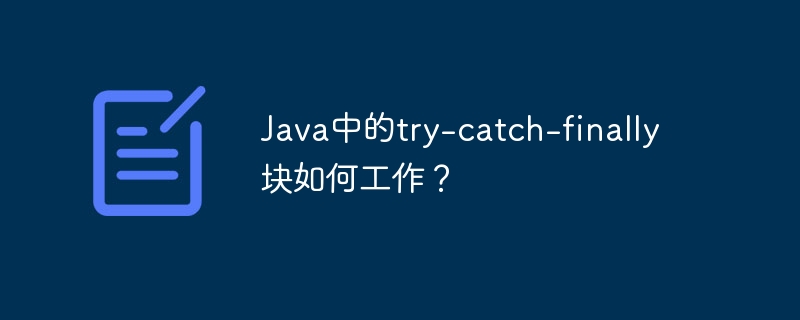How does try-catch-finally block work in Java?
try-catch-finally blocks are used for exception handling: try blocks contain code that may throw exceptions. A catch block handles a specific exception type and there can be multiple catch blocks. The finally block will be executed regardless of whether an exception is thrown, and is often used to release resources.

How does try-catch-finally block work in Java?
try-catch-finally block is an exception handling mechanism that allows us to specify the parts of the code where exceptions may occur so that we can handle these exceptions gracefully and prevent the application from crashing.
Syntax:
try {
// 放置可能抛出异常的代码
} catch (ExceptionName1 e) {
// 如果抛出 ExceptionName1 类型异常,处理它
} catch (ExceptionName2 e) {
// 如果抛出 ExceptionName2 类型异常,处理它
} finally {
//无论是否抛出异常,此处代码始终会执行
}How it works:
- try block: Contains possible Code that throws an exception.
- catch block: Specifies the specific exception types that can be caught. If the code in the try block throws the exception, the catch block is entered. There can be multiple catch blocks to handle different exception types.
- finally block: The code in the finally block will be executed regardless of whether an exception is thrown. Typically used to release resources (such as open files or database connections).
Practical case:
The following code demonstrates how to use the try-catch-finally block to handle file read exceptions.
try {
// 读取文件
BufferedReader reader = new BufferedReader(new FileReader("myfile.txt"));
String line = reader.readLine();
// 使用读取的行执行操作
} catch (FileNotFoundException e) {
// 处理文件未找到异常
System.out.println("文件未找到!");
} catch (IOException e) {
// 处理读取文件时发生的输入/输出异常
System.out.println("无法读取文件!");
} finally {
// 关闭文件,释放资源
reader.close();
}In the above example:
- The try block attempts to read the file and, if successful, uses the lines read.
- catch block handles "FileNotFoundException" (if the file is not found) and "IOException" (if an input/output exception occurs while reading the file).
- The finally block is always executed, the file is closed, and resources are released.
Using try-catch-finally blocks ensures that your application runs gracefully even when encountering exceptions, preventing crashes and providing a better user experience.
The above is the detailed content of How does try-catch-finally block work in Java?. For more information, please follow other related articles on the PHP Chinese website!

Hot AI Tools

Undresser.AI Undress
AI-powered app for creating realistic nude photos

AI Clothes Remover
Online AI tool for removing clothes from photos.

Undress AI Tool
Undress images for free

Clothoff.io
AI clothes remover

Video Face Swap
Swap faces in any video effortlessly with our completely free AI face swap tool!

Hot Article

Hot Tools

Notepad++7.3.1
Easy-to-use and free code editor

SublimeText3 Chinese version
Chinese version, very easy to use

Zend Studio 13.0.1
Powerful PHP integrated development environment

Dreamweaver CS6
Visual web development tools

SublimeText3 Mac version
God-level code editing software (SublimeText3)

Hot Topics
 Is the company's security software causing the application to fail to run? How to troubleshoot and solve it?
Apr 19, 2025 pm 04:51 PM
Is the company's security software causing the application to fail to run? How to troubleshoot and solve it?
Apr 19, 2025 pm 04:51 PM
Troubleshooting and solutions to the company's security software that causes some applications to not function properly. Many companies will deploy security software in order to ensure internal network security. ...
 How to elegantly obtain entity class variable names to build database query conditions?
Apr 19, 2025 pm 11:42 PM
How to elegantly obtain entity class variable names to build database query conditions?
Apr 19, 2025 pm 11:42 PM
When using MyBatis-Plus or other ORM frameworks for database operations, it is often necessary to construct query conditions based on the attribute name of the entity class. If you manually every time...
 How to simplify field mapping issues in system docking using MapStruct?
Apr 19, 2025 pm 06:21 PM
How to simplify field mapping issues in system docking using MapStruct?
Apr 19, 2025 pm 06:21 PM
Field mapping processing in system docking often encounters a difficult problem when performing system docking: how to effectively map the interface fields of system A...
 How do I convert names to numbers to implement sorting and maintain consistency in groups?
Apr 19, 2025 pm 11:30 PM
How do I convert names to numbers to implement sorting and maintain consistency in groups?
Apr 19, 2025 pm 11:30 PM
Solutions to convert names to numbers to implement sorting In many application scenarios, users may need to sort in groups, especially in one...
 How does IntelliJ IDEA identify the port number of a Spring Boot project without outputting a log?
Apr 19, 2025 pm 11:45 PM
How does IntelliJ IDEA identify the port number of a Spring Boot project without outputting a log?
Apr 19, 2025 pm 11:45 PM
Start Spring using IntelliJIDEAUltimate version...
 How to safely convert Java objects to arrays?
Apr 19, 2025 pm 11:33 PM
How to safely convert Java objects to arrays?
Apr 19, 2025 pm 11:33 PM
Conversion of Java Objects and Arrays: In-depth discussion of the risks and correct methods of cast type conversion Many Java beginners will encounter the conversion of an object into an array...
 E-commerce platform SKU and SPU database design: How to take into account both user-defined attributes and attributeless products?
Apr 19, 2025 pm 11:27 PM
E-commerce platform SKU and SPU database design: How to take into account both user-defined attributes and attributeless products?
Apr 19, 2025 pm 11:27 PM
Detailed explanation of the design of SKU and SPU tables on e-commerce platforms This article will discuss the database design issues of SKU and SPU in e-commerce platforms, especially how to deal with user-defined sales...
 How to elegantly get entity class variable name building query conditions when using TKMyBatis for database query?
Apr 19, 2025 pm 09:51 PM
How to elegantly get entity class variable name building query conditions when using TKMyBatis for database query?
Apr 19, 2025 pm 09:51 PM
When using TKMyBatis for database queries, how to gracefully get entity class variable names to build query conditions is a common problem. This article will pin...






